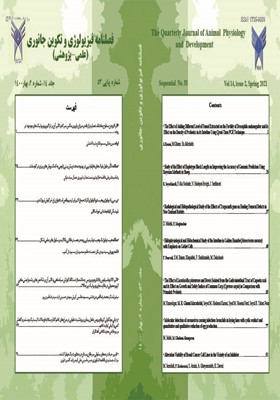تغییر حیات رده های سلولی سرطان پستان در مجاورت یک مهارکننده DOR: 20.1001.1.17359880.1400.14.2.7.6
محورهای موضوعی : مجله پلاسما و نشانگرهای زیستیمزدک جمشید ی 1 , فاطمه کشاورزی 2 , صبریه امینی 3 , علی قیصرزاده 4 , کامبیز داوری 5
1 - گروه زیستشناسی، واحد سنندج ، دانشگاه آزاد اسلامی،سنندج، ایران.
2 - گروه زیست شناسی، واحد سنندج، دانشگاه آزاد اسلامی، سنندج، ایران.
3 - گروه زیست شناسی، واحد سنندج، دانشگاه آزاد اسلامی، سنندج، ایران.
4 - مرکز تحقیقات میکروبشناسی بالینی، دانشگاه علوم پزشکی ایلام، ایلام، ایران.
گروه زیست شناسی سه بعدی، دانشکده علوم، دانشگاه ایلام، ایلام، ایران.
5 - گروه زیست شناسی، واحد سنندج، دانشگاه آزاد اسلامی، سنندج ایران.
کلید واژه: تومورهای بسیار مهاجم پستان, مهار کننده, روش درمانی,
چکیده مقاله :
زمینه و هدف: کارسینوم های پستان ، تومورهای بسیار مهاجم با پیش آگهی ضعیف هستند که با فراوانی بیشتر زنان جوانتر(سن کمتر از50 سال) را درگیر می کنند. گرچه در ابتدا بسیار حساس به شیمی درمانی هستند، ولی به طور قابل توجهی مهاجم تر از تومورهای دیگر زیرگروه های مولکولی می باشند. مطالعه حاضر با هدف یافتن یک روش درمانی جدید این سرطان ها انجام شد.روش کار: اساس روش در مرحله اول ساخت یک مهار کننده گیرنده های سطح سلولی بود. سپس اثر این مهار کننده بر رده های سلولی سرطانی پستان با استفاده از تست های معمول بررسی شد.یافته ها: یافته ها نشان داد که در غلظت های مناسب مهار کننده ، حیات رده های سلولی مربوطه به طور قابل توجهی تغییر می یابد.نتیجه گیری: مطالعه حاضر نشان داد که استفاده از این روش ها می تواند زمینه ساز درمان های آینده باشد.
Inroduction & Objective: Breast carcinomas are very invasive tumors with poor prognosis that are more common in younger women (less than 50 years old). Although initially sensitive to chemotherapy, they are significantly more aggressive than other tumors of the molecular subgroup. The aim of this study was to find a new treatment for these cancers. Materials and Methods: The basis of the method was the construction of an inhibitor of cell surface receptors, in the first stage. Then, the effects of this inhibitor on breast cancer cell lines were examined by the routine tests. Results: The results showed that at appropriate concentrations of inhibitor, the life of the respective cell lines is significantly altered. Conclusion: The present study showed that the use of these methods can pave the way for future treatments.
1.Anstey, EH., Shoemaker, ML., Barrera, CM., O’Neil, ME., Verma, AB., Holman DM. (2017). Breastfeeding and breast cancer risk reduction: implications for black mothers. Am J Prev Med, 53(3); S40-S6.
2.Azam, S., Lange, T., Huynh, S., Aro, AR., von Euler-Chelpin, M., Vejborg, I. . (2018). Hormone replacement therapy, mammographic density, and breast cancer risk: a cohort study. Cancer Causes Control, 29(6); 495-505.
3.Bryan, RM., Mercer, R.J., Bennett, RC., Rennie, GC., Lie, TH., Morgan, FJ. (1984). Androgen receptors in breast cancer. Cancer. 54(11); 2436-40.
4.Bazire L, De Rycke Y, Asselain B, Fourquet A, Kirova Y. Risks of second malignancies after breast cancer treatment: long-term results. Cancer/Radiothérapie. 2017;21(1):10-5.
5.Brind, J., Condly, SJ., Lanfranci, A., Rooney, B. (2018). Induced abortion as an independent risk factor for breast cancer: a systematic review and meta-analysis of studies on south asian women. Issues L & Med., 33;33-64.
6.Collins, LC., Cole, KS., Marotti, JD., Hu, R., Schnitt, SJ., Tamimi, RM. (2011). Androgen receptor expression in breast cancer in relation to molecular phenotype: results from the Nurses' Health Study. Modern Pathology., 24(7);924-930.
7.Johnson, MC. (2010). Anatomy and physiology of the breast. Management of breast diseases, 1-36.
8.Giuliano, AE., Kirgan, DM., Guenther, JM., Morton DL. (1994). Lymphatic mapping and sentinel lymphadenectomy for breast cancer. Ann Surg., 220(3); 391-395.
9.Satake, T., Matsuyama, M. (1991). Endocrine cells in a normal breast and non‐cancerous breast lesion. Pathol Int., 41(12); 874-8.
10.Kresovich, JK., Xu, Z., O’Brien, KM., Weinberg, CR., Sandler, DP., Taylor, JA. (2019). Methylation-based biological age and breast cancer risk. JNCI: Journal of the National Cancer Institute, 111(10); 1051-8.
11.Olsson, HL., Olsson, ML. (2020). The Menstrual cycle and risk of breast cancer: A Review. Front Oncol., 10; 33-98.
12.Kolak, A., Kamińska, M., Sygit , K., Budny, A., Surdyka, D., Kukiełka-Budny, B. (2017). Primary and secondary prevention of breast cancer. Ann Agric Environ Med., 24(4); 549-53.
13.Lee, KR., Hwang, IC., Han, KD., Jung, J., Seo, MH. (2018). Waist circumference and risk of breast cancer in Korean women: a nationwide cohort study. Int J Cancer., 142(8); 1554-9.
14.Yu, L., Tan, Y., Zhu, L. (2017). Dietary vitamin B2 intake and breast cancer risk: a systematic review and meta-analysis. Arch Gynecol Obstet., 295(3); 721-9.
15.Wendt, C., Margolin, S. (2019). Identifying breast cancer susceptibility genes–a review of the genetic background in familial breast cancer. Acta Oncol., 58(2); 135-46.
16.Rojas, K., Stuckey, A. (2016). Breast cancer epidemiology and risk factors. Clin Obstet Gynecol., 59(4); 651-72.
17.Hickey, T., Robinson, J., Carroll, J., Tilley, W. (2012). Minireview: the androgen receptor in breast tissues: growth inhibitor, tumor suppressor, oncogene? Molecular Endocrinology, 26(8); 1252-67.
18.Tworoger, SS., Missmer, SA., Eliassen, AH., Spiegelman, D., Folkerd, E., Dowsett, M. (2006).The association of plasma DHEA and DHEA sulfate with breast cancer risk in predominantly premenopausal women. Cancer Epidemiology and Prevention Biomarkers., 15(5); 967-71.
19.Gonzalez, LO., Corte, MD., Vazquez, J., Junquera, S., Sanchez, R., Alvarez, AC. (2008). Androgen receptor expresion in breast cancer: relationship with clinic pathological characteristics of the tumors, prognosis, and expression of metalloproteases and their inhibitors. BMC Cancer., 8(1);149-156.
20.Patil, JB., Kim, J., Jayaprakasha, G. (2010). Berberine induces apoptosis in breast cancer cells(MCF-7) through mitochondrial-dependent pathway. European Journal of Pharmacology., 645(1); 70-8.
21.Lu, B., Hu, M., Peng, J. (2010). Cytotoxicity of berberine on human cervical carcinoma HeLa cells through mitochondria, death receptor and MAPK pathways, and in-silico drug-target prediction. Toxicology in Vitro. 24(6); 1482-90.
22.Mazumder, PM. DS., Das, MK. (2011). Phyto-pharmacology of Berberis aristata DC: a review. Journal of Drug Delivery and Therapeutics, 1(2);12-18.
23.Mukama, T., Kharazmi, E., Sundquist, K., Sundquist, J., Brenner, H., Fallah, M. (2020). Familial risk of breast cancer by dynamic, accumulative, and static definitions of family history. Cancer., 126(12); 2837-48.


